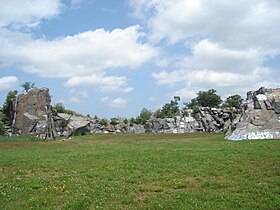Quincy Quarries Reservation
| Quincy Quarries Reservation | |
| Metropolitan Park System of Greater Boston | |
|
View across earth-filled quarry
|
|
| Country | United States |
|---|---|
| State | Massachusetts |
| County | Norfolk |
| City | Quincy |
| Coordinates | 42°14′35″N 71°2′4″W / 42.24306°N 71.03444°WCoordinates: 42°14′35″N 71°2′4″W / 42.24306°N 71.03444°W |
| Area | 22 acres (9 ha) |
| Established | 1985 |
| Management | Massachusetts Department of Conservation and Recreation |
| Website: Quincy Quarries | |
The Quincy Quarries in Quincy, Massachusetts, produced granite for over a century and were the site of the Granite Railway—often credited as being the first railroad in the United States. A 22-acre (8.9 ha) section of the former quarries is owned and operated by the Massachusetts Department of Conservation and Recreation as a public recreation area.
In 1825, after an exhaustive search throughout New England, Solomon Willard selected the Quincy site as the source of stone for the Bunker Hill Monument in Charlestown. After many delays and much obstruction, a charter was granted on March 4, 1826 for the construction of a railroad to help move the granite. The "Granite Railway" was designed and built by railway pioneer Gridley Bryant and began operations on October 7, 1826. The granite from these quarries became famous throughout the nation, and stone cutting quickly became Quincy's principal economic activity.
The last active quarry closed in 1963. After their abandonment, the open quarries filled with rainwater and ground water. The flooded quarries soon became a popular spot for cliff jumping. However, many people were injured—and killed—while diving into the quarries from great heights. This led the police and the city of Quincy to grapple with what to do with this abandoned space.
During this period, the quarries were also discovered by rock climbers. In 1968, A Guide to Quincy Quarries by Willie Crowther and Tony Thompson, published by the MIT Outing Club, contained information about climbing in and around the quarries; a second edition was published in 1970.Boston Rocks, a guidebook by Larry LaForge, was published by the MIT Outing Club in 1987; a second edition by Richard Doucette and Susan Ruff came out in 2003 with a copyright update in 2008.
...
Wikipedia


